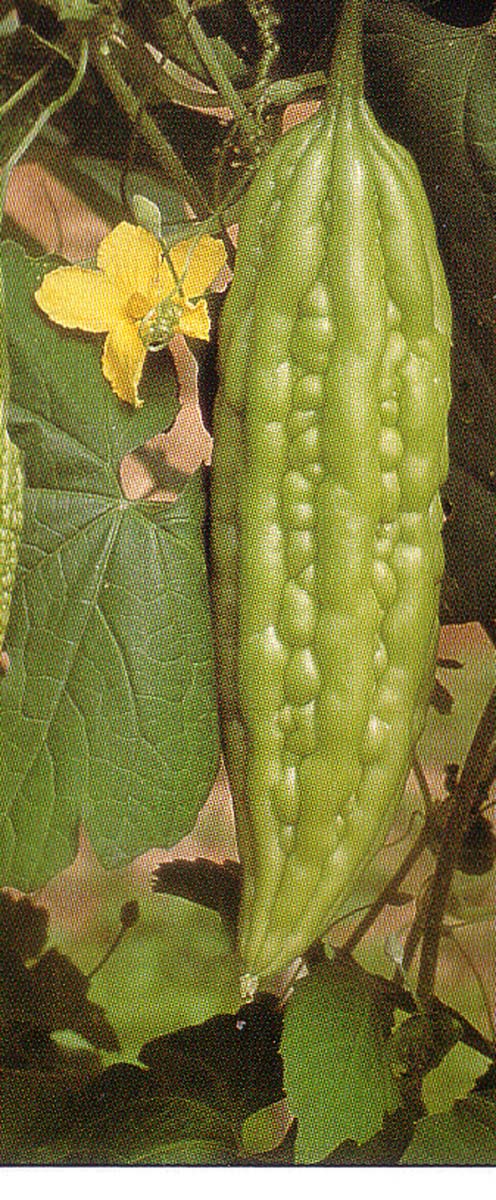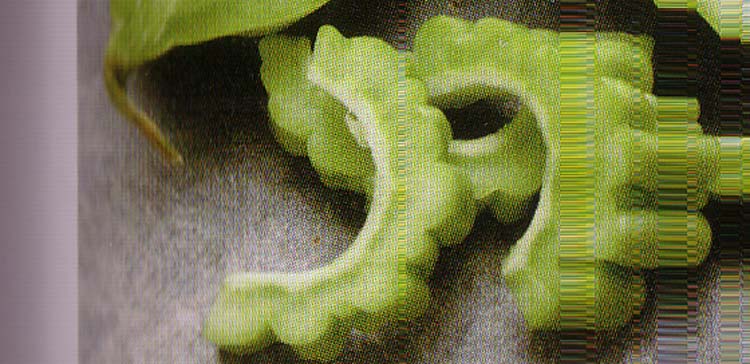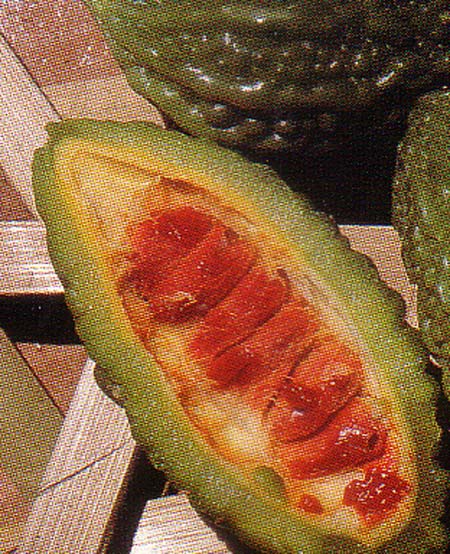|
Read 13079240 times
Connect me to:
|
Bitter Melons Need LoveVegetables and Vegetarian Foods
Spring Volume: 2014 Issue: 21(1) page(s): 24 25, and 36
 Many people do not give this funny-lumpy-looking seed-filled item a second look. Is it because they know it tastes bitter and can taste like quinine? Other bitter foods seem to be in vogue, why not this Momordica charantia, its botanical name. Why is this less loved than other bitter foods? Do they know it came to China from India in the 1300s? Do they know it is literally the fruit of a vine? Is their displeasure because it has so many bumps which some call warts? Maybe it is because it originally came from Malaysia and is shared growing all over the tropics and much of the rest of the world? Many people do not give this funny-lumpy-looking seed-filled item a second look. Is it because they know it tastes bitter and can taste like quinine? Other bitter foods seem to be in vogue, why not this Momordica charantia, its botanical name. Why is this less loved than other bitter foods? Do they know it came to China from India in the 1300s? Do they know it is literally the fruit of a vine? Is their displeasure because it has so many bumps which some call warts? Maybe it is because it originally came from Malaysia and is shared growing all over the tropics and much of the rest of the world?
This long and often skinny fruit has several names, pear among them. It is no relation to any known pear, not even the alligator pear, its other common name. Some say it looks nasty, maybe in another life it rubbed shoulders with something primordial. One of its other names is balsam pear. Did you even wonder why? We did but have no answer as to how it was given its names. Another is karella, still others are 'beautiful lichee' and 'ugly grape.' Now there is a pair of names that make no sense. These last two are English for two of its Chinese names, jin lizhi and lao putao. We know not how they came into being and know no one who does; do you?    The Chinese often call this fruit a ku gua, lia gua, or liang gua. Do any of them translate to cool melon? Afterall, gua does mean melon. One friend says it is cool and we think she means it functions that way. Another gal said it is known in some places as 'goya' fruit and that there are folks who eat its leaves and stems when the fruit is young. Another health food gal said this fruit stimulates digestion. Is there a connection we fail to see? The Chinese often call this fruit a ku gua, lia gua, or liang gua. Do any of them translate to cool melon? Afterall, gua does mean melon. One friend says it is cool and we think she means it functions that way. Another gal said it is known in some places as 'goya' fruit and that there are folks who eat its leaves and stems when the fruit is young. Another health food gal said this fruit stimulates digestion. Is there a connection we fail to see?
What we do know is that it does not look like an alligator or a pear, and that all species do not have the same size bumps as the tiny ones are India; but they are a different variety. The Chinese variety is not those tiny warty-looking ones as those grown on the Indian sub-continent. What we know is that bitter melon grows on vines that have male and female flowers on the same plant, and that they open only once. In spite of that, they attract lots of fruit flies and other flying insects. Also, when older and more ripe, and when they are cut one in half, the seeds are bright red. We also know that the fruit flies and their flying insect brethren keep away if a paper bag is tied at the fruit's top and left open at the bottom. Then these insects do not even enter. Why is that? We wonder if their name turns people off. Some believe that would only be true for the English speakers. We think this fruit has much potential and needs love. Brewers seem to agree as it is often the bittering agent when making many Chinese beers. Our recommendation, give them a try. Chinese medical practitioners say this fruit is cooling. We say to reduce its bitterness, blanch it and then cook it in one of many ways. Peel it first, remove the seeds next, and then combine it with meat as that makes a good combination. One thing worth knowing, this melon's seeds contain vicine. Those susceptible to favism, the seeds can trigger related symptoms. Eat too much of the fruit and any red arils from them can be toxic for small children. Pregnant women should not eat them, either. One thing to do, cook these fruits for a long time to reduce any problems. Some like to shred the pulp, we like to cube it. Actually, sautee it either way and prepare it with shredded pork or another meat is a good way to cook it, they are a good combination. For those who want to know more about preparing this fruit always used as a vegetable, read Wonona Wong Chang's article in the 2003 Volume 10 of Flavor and Fortune. This Number 3 issue is on this magazine's website. For those who want to know more about it medicinal properties, TCM practitioners say it has many good features. One chap called them 'anti-properties'. He said these include anti-malarial, anti-viral, and anti-cancer ones. He also said they are cardio-protective and he recommends them to diabetics because eating them increases insulin sensitivity as they include a compound that regulates glucose uptake, something often impaired in folks with diabetes. They also have a positive impact on the stomach, help the heart, liver, and lungs, and relieve heat stroke; they brighten eyes and neutralize many poisons. One other thing, several medical practitioners told us that in combination with Chinese yam, this fruit helps one lose weight, is of value to those with dysentery, colic, and fever, and is good for burns when used on them as a poultice. One fellow also suggested eating the fruit for birth control. We suggest stir-frying the pulp with pickled mustard greens and hot chili peppers. To learn more, do read that article about this food in this magazine, and in others. It wrote about the National Bitter Melon Council and suggested contacting them at: www.bittermelon.org We did not advise but should have, that for stomach ailments, mix this fruit with honey or olive oil or both to increase its positive impacts. This vine is best grown on a trellis as one should with other climbing Cucurbitae such as silk squash. And do not forget that fruit flies and other flying insects adore them so cover them with paper or plastic bags left open at the bottom.
TCM practitioners also told us that a grated tablespoon of bitter melon, two teaspoons of minced scallion, and one teaspoon of fresh minced ginger make a good tea for those with a cold and a temperature. Without the scallion and fresh ginger, this mixture is good for excessive thirst and for sunstroke. One TCM chap said to add the leaves dried in the sun and to mix them with Chinese rice wine and make a poultice if one has boils or carbuncles. Bitter melon does need loving in medicinal ways and in cooking. Therefore, try the recipes below and do love and not shun them. The first recipe is good with both young and old fruit. Note the old yellow ones are in the picture. Other recipes are better with green and younger fruits.
|

 Many people do not give this funny-lumpy-looking seed-filled item a second look. Is it because they know it tastes bitter and can taste like quinine? Other bitter foods seem to be in vogue, why not this Momordica charantia, its botanical name. Why is this less loved than other bitter foods? Do they know it came to China from India in the 1300s? Do they know it is literally the fruit of a vine? Is their displeasure because it has so many bumps which some call warts? Maybe it is because it originally came from Malaysia and is shared growing all over the tropics and much of the rest of the world?
Many people do not give this funny-lumpy-looking seed-filled item a second look. Is it because they know it tastes bitter and can taste like quinine? Other bitter foods seem to be in vogue, why not this Momordica charantia, its botanical name. Why is this less loved than other bitter foods? Do they know it came to China from India in the 1300s? Do they know it is literally the fruit of a vine? Is their displeasure because it has so many bumps which some call warts? Maybe it is because it originally came from Malaysia and is shared growing all over the tropics and much of the rest of the world?

 The Chinese often call this fruit a ku gua, lia gua, or liang gua. Do any of them translate to cool melon? Afterall, gua does mean melon. One friend says it is cool and we think she means it functions that way. Another gal said it is known in some places as 'goya' fruit and that there are folks who eat its leaves and stems when the fruit is young. Another health food gal said this fruit stimulates digestion. Is there a connection we fail to see?
The Chinese often call this fruit a ku gua, lia gua, or liang gua. Do any of them translate to cool melon? Afterall, gua does mean melon. One friend says it is cool and we think she means it functions that way. Another gal said it is known in some places as 'goya' fruit and that there are folks who eat its leaves and stems when the fruit is young. Another health food gal said this fruit stimulates digestion. Is there a connection we fail to see?